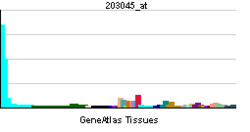- NINJ1
-
Ninjurin 1 Identifiers Symbols NINJ1; NIN1; NINJURIN External IDs OMIM: 602062 HomoloGene: 88815 GeneCards: NINJ1 Gene Gene Ontology Molecular function • protein binding Cellular component • membrane
• integral to membraneBiological process • cell adhesion
• nervous system development
• tissue regenerationSources: Amigo / QuickGO RNA expression pattern 
More reference expression data Orthologs Species Human Mouse Entrez 4814 18081 Ensembl ENSG00000131669 ENSMUSG00000037966 UniProt Q92982 n/a RefSeq (mRNA) NM_004148 NM_013610.2 RefSeq (protein) NP_004139 NP_038638.1 Location (UCSC) Chr 9:
95.88 – 95.9 MbChr 13:
49.28 – 49.29 MbPubMed search [1] [2] Ninjurin-1 is a protein that in humans is encoded by the NINJ1 gene.[1][2]
References
- ^ Araki T, Milbrandt J (Oct 1996). "Ninjurin, a novel adhesion molecule, is induced by nerve injury and promotes axonal growth". Neuron 17 (2): 353–61. doi:10.1016/S0896-6273(00)80166-X. PMID 8780658.
- ^ "Entrez Gene: NINJ1 ninjurin 1". http://www.ncbi.nlm.nih.gov/sites/entrez?Db=gene&Cmd=ShowDetailView&TermToSearch=4814.
Further reading
- Guimarães PE, Fridman C, Gregório SP, et al. (2007). "WITHDRAWN: Association between polymorphisms in genes of inflammatory response and axonal repair with spinal cord injury.". Spinal Cord. doi:10.1038/sj.sc.3102122. PMID 17893696.
- Cardoso CC, Martinez AN, Guimarães PE, et al. (2007). "Ninjurin 1 asp110ala single nucleotide polymorphism is associated with protection in leprosy nerve damage.". J. Neuroimmunol. 190 (1–2): 131–8. doi:10.1016/j.jneuroim.2007.07.015. PMID 17825431.
- Gerhard DS, Wagner L, Feingold EA, et al. (2004). "The status, quality, and expansion of the NIH full-length cDNA project: the Mammalian Gene Collection (MGC)". Genome Res. 14 (10B): 2121–7. doi:10.1101/gr.2596504. PMC 528928. PMID 15489334. http://www.pubmedcentral.nih.gov/articlerender.fcgi?tool=pmcentrez&artid=528928.
- Toyama T, Sasaki Y, Horimoto M, et al. (2005). "Ninjurin1 increases p21 expression and induces cellular senescence in human hepatoma cells". J. Hepatol. 41 (4): 637–43. doi:10.1016/j.jhep.2004.06.027. PMID 15464245.
- Humphray SJ, Oliver K, Hunt AR, et al. (2004). "DNA sequence and analysis of human chromosome 9". Nature 429 (6990): 369–74. doi:10.1038/nature02465. PMC 2734081. PMID 15164053. http://www.pubmedcentral.nih.gov/articlerender.fcgi?tool=pmcentrez&artid=2734081.
- Ota T, Suzuki Y, Nishikawa T, et al. (2004). "Complete sequencing and characterization of 21,243 full-length human cDNAs". Nat. Genet. 36 (1): 40–5. doi:10.1038/ng1285. PMID 14702039.
- Strausberg RL, Feingold EA, Grouse LH, et al. (2003). "Generation and initial analysis of more than 15,000 full-length human and mouse cDNA sequences". Proc. Natl. Acad. Sci. U.S.A. 99 (26): 16899–903. doi:10.1073/pnas.242603899. PMC 139241. PMID 12477932. http://www.pubmedcentral.nih.gov/articlerender.fcgi?tool=pmcentrez&artid=139241.
- Chadwick BP, Heath SK, Williamson J, et al. (1998). "The human homologue of the ninjurin gene maps to the candidate region of hereditary sensory neuropathy type I (HSNI)". Genomics 47 (1): 58–63. doi:10.1006/geno.1997.5084. PMID 9465296.
- Araki T, Zimonjic DB, Popescu NC, Milbrandt J (1997). "Mechanism of homophilic binding mediated by ninjurin, a novel widely expressed adhesion molecule". J. Biol. Chem. 272 (34): 21373–80. doi:10.1074/jbc.272.34.21373. PMID 9261151.
Categories:- Human proteins
- Chromosome 9 gene stubs
Wikimedia Foundation. 2010.
